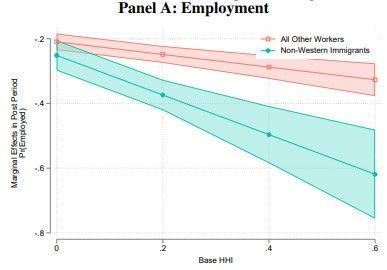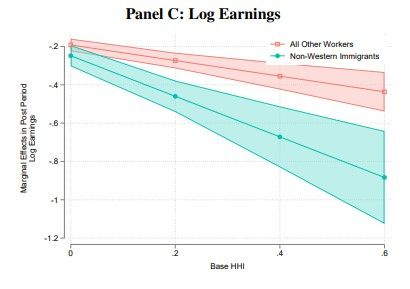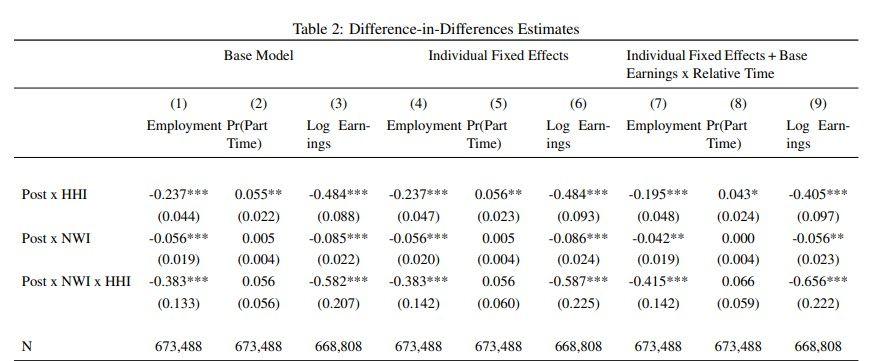"I say unto you, pray for your enemies."
10.09.2025 21:18 — 👍 2 🔁 0 💬 0 📌 0
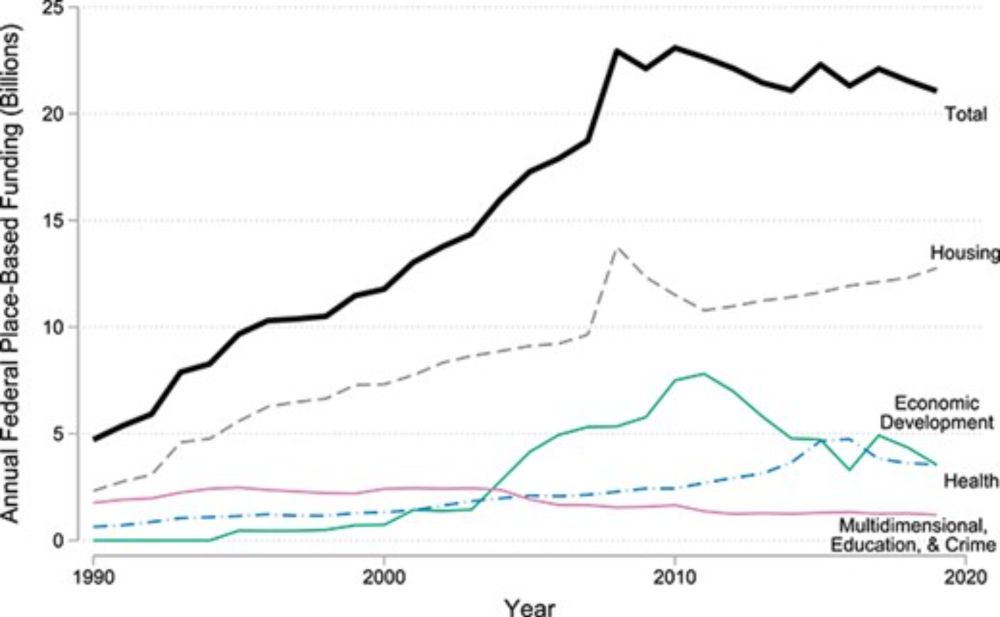
Federal place-based policy and the geography of inequality in the United States, 1990–2019
Abstract. This paper assesses the growth and spatial distribution of federal place-based policies in the United States. Using a novel dataset of federal pl
📣 Hot off the press 📣
We document tremendous growth in U.S. federal place-based funding, show it has disproportionately gone to areas with more nonprofits & stronger housing markets, and find a pattern of cumulative advantage in funding among high-poverty neighborhoods.
doi.org/10.1093/sf/s...
29.07.2025 21:00 — 👍 27 🔁 14 💬 1 📌 1
How should elected officials divine voters’ preferences about building more homes: through broad-based polls or the 12 people who show up at a community meeting on Tuesday night and yell for hours? Hard to say…
13.05.2025 21:33 — 👍 101 🔁 22 💬 1 📌 0
A strongly worded letter isn't gonna cut it.
01.05.2025 21:47 — 👍 0 🔁 0 💬 0 📌 0
https://www.iza.org/publications/dp/17830/the-power-to-discriminate
There is a lot more detail in the paper, including tests to rule out people's favorite alternative explanations.
t.co/xObtAFPZOh
16.04.2025 15:00 — 👍 0 🔁 0 💬 0 📌 0
Greater labor market competition has an equalizing effect across workers & helps to reduce discrimination. But so does good information about where each worker stands in his/her true productivity--when employers don't rely on coarse proxies like demographic group.
16.04.2025 15:00 — 👍 1 🔁 0 💬 1 📌 0
What stands out is that in the concentrated markets, the firms most likely to hire non-Western immigrants have managers who have more prior work experience with immigrants-those who know their productivity best! Another signal of *information* & beliefs being the culprit.
16.04.2025 15:00 — 👍 0 🔁 0 💬 1 📌 0
Second-generation immigrants don't experience the same discriminatory gaps. Neither do immigrants who have been in the country for ~20 years or immigrants from western Europe & the US.
16.04.2025 15:00 — 👍 0 🔁 0 💬 1 📌 0
We use the richness of the data to rule out a bunch of other mechanisms like different job search, social networks, being hired at firms with immigrant managers, take-up of social programs, or sorting into different occupations. None of these explain the gaps.
16.04.2025 15:00 — 👍 0 🔁 0 💬 1 📌 0

What's remarkable is that these gaps are there even when both workers are displaced from the same firm but then re-hired into the same firm! In other words, the immigrant is paid far less than his co-worker at the same company even when they were paid the same before the layoff!
16.04.2025 15:00 — 👍 0 🔁 0 💬 1 📌 0
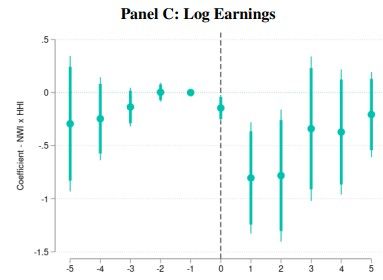
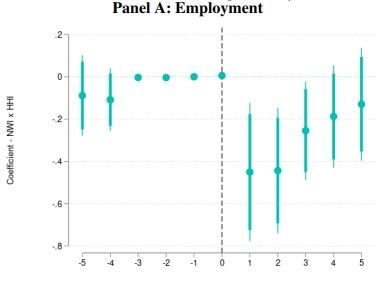
By the 4th year after the layoff, gaps even in the most concentrated labor markets close, implying the discrimination is based on beliefs about the average productivity differences between immigrants & natives.
16.04.2025 15:00 — 👍 0 🔁 0 💬 1 📌 0
So what kind of discrimination is this? Taste-based (prejudice/animus) or based on beliefs about their productivity (like statistical discrimination)? If tastes, there's not much reason for gaps between the workers to close. But beliefs can update over time & gaps will close.
16.04.2025 15:00 — 👍 0 🔁 0 💬 1 📌 0
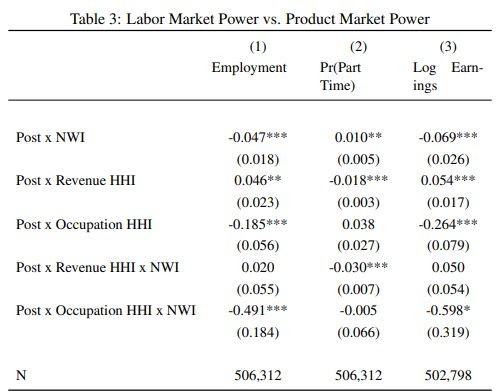
Competition STRONGLY reduces discrimination among employers, but does not quite completely eliminate it (call it win for Becker). Next we measure if this is labor market power or product market power that matters. Looks like it's loading entirely on labor market power.
16.04.2025 15:00 — 👍 0 🔁 0 💬 1 📌 0
We measure market competition by the concentration (HHI) of employment in the year their firm closure or mass layoff. 1=one single employer for everyone in that occupation in their city. We then track the gaps between the worker pairs as they search in a diff-in-diff setting.
16.04.2025 15:00 — 👍 0 🔁 0 💬 1 📌 0

Suddenly, their firm closes, & they are forced to look for a new job. Prior to the firm closing, the market valued their skills EXACTLY the same. Immigrant-native gaps after their search can tell us about discrimination--especially the difference between the two pairs.
16.04.2025 15:00 — 👍 0 🔁 0 💬 1 📌 0

Imagine you have four workers-2 immigrants & 2 natives working at the same firm doing the same job for the same pay. One pair (1 immigrant & 1 native) work in a city where there are lots of employers that will hire for their occupation. For the other, there are fewer employers.
16.04.2025 15:00 — 👍 0 🔁 0 💬 1 📌 0

Our context is Norway--long considered one of the most egalitarian societies in the world--and discrimination against immigrants from outside of 'the West.' If we can find discrimination there, it's likely to be in other places. So how do we investigate this?
16.04.2025 15:00 — 👍 1 🔁 0 💬 1 📌 0
The Power to Discriminate
This paper examines the relationship between labor market power and employer discrimination, providing new causal evidence on when and where discrimin...
iza.org/publications...
A long history of economic theory says that sufficient competition should kill discrimination, but that's been mostly focused on product market competition. We look at the role of labor market competition in allowing for discrimination.
16.04.2025 15:00 — 👍 1 🔁 0 💬 1 📌 0
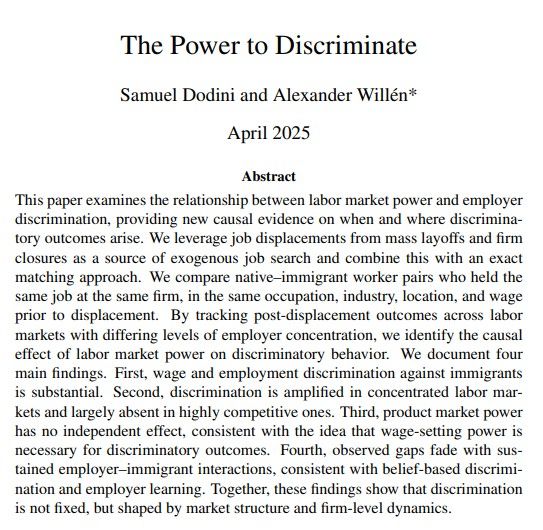
🚨🚨 Does labor market discrimination drive economic gaps? Can market competition eliminate discrimination like economic theory suggests? What *kind* of discrimination are we talking about. In a new paper, Alex Willen & I explore the question. #Econsky
16.04.2025 15:00 — 👍 15 🔁 2 💬 1 📌 0
Final_Version_of_Tarrifs_actualFINALcopy_version7_USETHISONE.docx
09.04.2025 18:39 — 👍 23609 🔁 4945 💬 292 📌 240
The Fatal Consequences of Brain Drain
This paper examines the welfare consequences of reallocating high-skilled labor across borders. A labor demand shock in Norway—driven by a surge in oi...
There is a lot more in the working paper!
Human capital retention matters in strategic sectors like healthcare, so policies should reflect the balance between these priorities and public systems should be responsive to local economic conditions.
www.iza.org/publications...
08.04.2025 17:37 — 👍 0 🔁 0 💬 0 📌 0

So what happened in Norway? We are not able to detect any measurable effect of the incoming commuters on mortality events, physician retention, or other metrics in Norway. There appears to have been no offsetting gain in Norway.
08.04.2025 17:37 — 👍 1 🔁 0 💬 1 📌 0
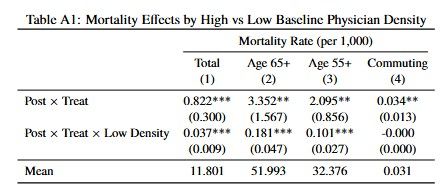
The effects hit hardest in areas with lower physician density before the commuting started. So the out-commuting of doctors increased inequality across classes and across places within Sweden.
08.04.2025 17:37 — 👍 0 🔁 0 💬 1 📌 0
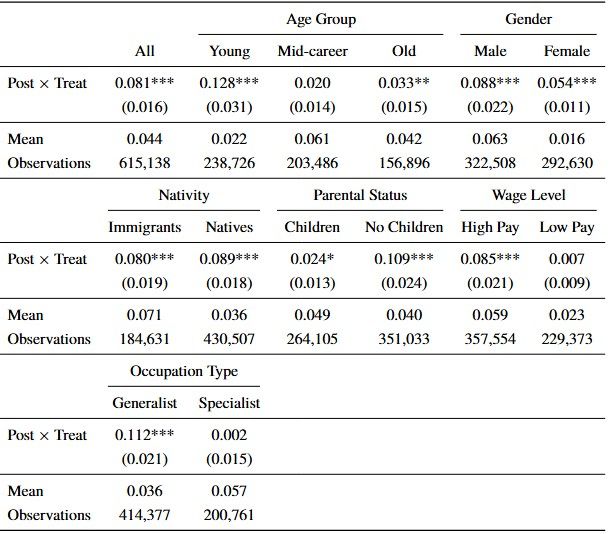
These illnesses are more likely to require emergency care. Guess which physicians were most likely to commute? High-skilled, young, generalists--those most likely to staff emergency departments.
08.04.2025 17:37 — 👍 0 🔁 0 💬 1 📌 0
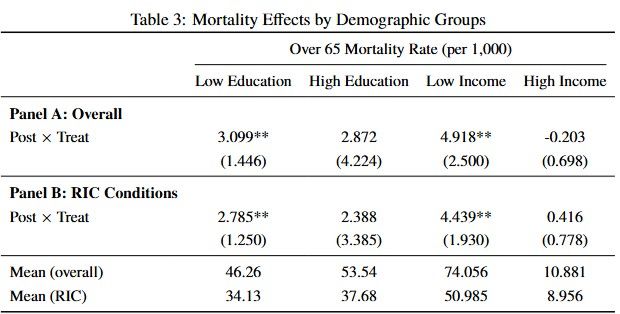
The effects are driven by lower-income people who are most dependent on the public healthcare system. The same is true for education, but the gradient is less steep. The effects are mostly drive by respiratory, infection, & circulatory illnesses.
08.04.2025 17:37 — 👍 0 🔁 0 💬 1 📌 0
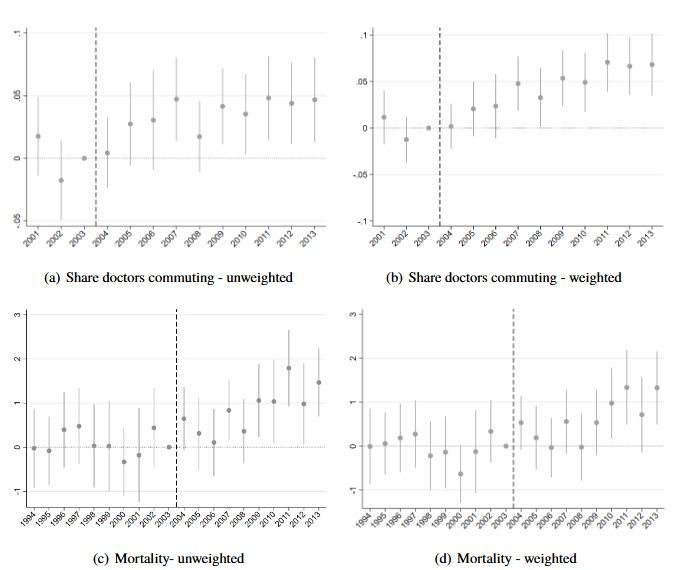
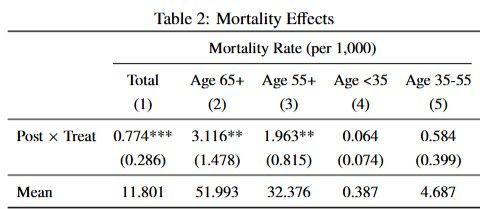
In a dose-response diff-in-diff, areas with lower baseline physician wages lost more doctors to commuting and had significant increases in their mortality rates, particularly people age 65+. 1 log point lower baseline earnings increased 65+ mortality by 3 per 1,000.
08.04.2025 17:37 — 👍 0 🔁 0 💬 1 📌 0
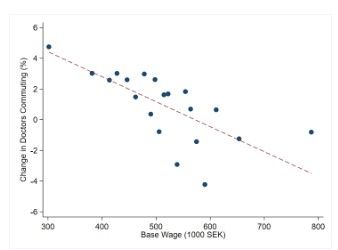
Places with lower physician earnings in 2003 saw the biggest increases in this 'out-commuting' of physicians. These municipalities lost a substantial amount of human capital--brain drain--but not due to permanent migration.
08.04.2025 17:37 — 👍 0 🔁 0 💬 1 📌 0
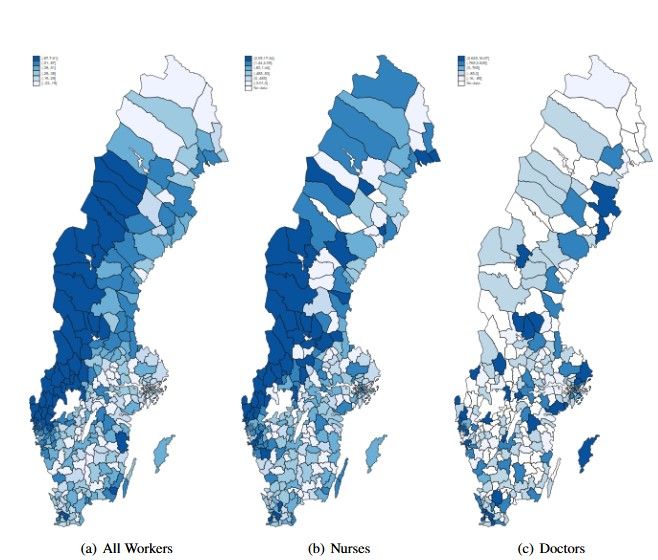
Doctors were unique though. While nearly everyone else who started commuting to Norway lived near the border, doctors started doing more frequent and longer short stints in Norway--weekends, full weeks, or even months on end--coming from all over Sweden.
08.04.2025 17:37 — 👍 0 🔁 0 💬 1 📌 0
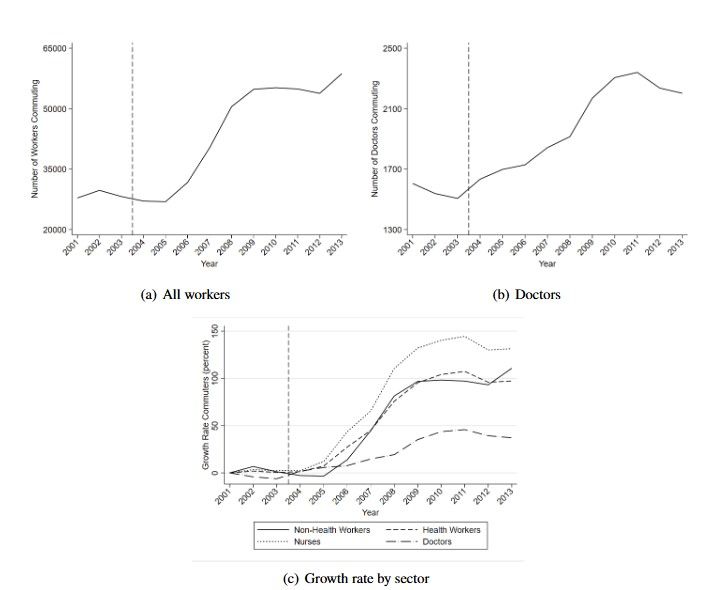
In 2004, wages in Norway started surging due to oil prices & major growth in labor demand. This made it highly attractive for Swedes to work in Norway. Suddenly, you could make nearly double your Swedish wage, and people responded!
www.iza.org/publications...
08.04.2025 17:37 — 👍 0 🔁 0 💬 1 📌 0
Senior Editor @TheUnPopulist.net. Executive Director @ismapolicy.bsky.social. Philosophy lecturer. Soccer knower. 🇺🇸 🇦🇷
Economics PhD student at Cornell University. I research economic mobility + [im]migration + record linking w/methods from labor econ, econ history, and econ demography. Road + trail runner
adrianhaws.com
Sociologist @PSTC_Brown @AnnenbergInst studying education, neighborhoods, social policy, and inequality & former K12 teacher
Luxembourg Institute of Socio-Economic Research (LISER) is an independent research institute addressing societal challenges & providing policy advice.
https://www.liser.lu/
IZA Institute of Labor Economics: advancing global labor market research from Bonn, Germany, with a network of 2,200+ experts worldwide.
More about us: www.iza.org
Labor economist. Views are my own and not those of my employer.
PhD candidate at CREST (École Polytechnique/ENSAE) | Incoming postdoctoral fellow at Bocconi University & IGIER | Assistant Professor at LMU Munich (starting 2026).
Labor, Gender and Inequality
Website: https://sites.google.com/site/federicameluzzi1
Economist at Harvard
https://www.augustinbergeron.com
Economist @ Minneapolis Fed's Opportunity & Inclusive Growth Institute. There's a graph for that. Views are my own. (she/her) https://albrightalex.com/
Harvard Magazine is a bimonthly magazine that balances intellectual substance with human interest, educating and entertaining readers with reporting on research and breakthroughs in business, the arts, literature, tech, science, higher education, and more.
Labor, monopsony, worker's rights, globalization, future of work. https://www.luc.edu/quinlan/whyquinlan/facultyandstaff/profiles/peternorlander.shtml
Economics (UBC), yimby, replication, effective altruism, data science.
Charles W. Eliot Professor and President Emeritus at Harvard, former Secretary of the Treasury for President Clinton
Subscribe to www.lawdork.com for SCOTUS, Trump, LGBTQ, criminal justice, and other legal news. / Email: lawdorknews@gmail.com / Signal: crg.32 / About me: Sober. Queer. Bipolar. Buckeye. / He/him.
Behavioral Economist | Assistant Professor of Economics @UniMannheim| Interested in Econ, Law, Psychology, Philosophy, ...
We are an economics podcast that delves into the lives and ideas of famous economists. We once won the Independent Podcast of the Year in the PodBible Awards. We believe in 'Economics for Everyone'! https://open.spotify.com/show/44pI1bcAKbrA2fLZpwJF4
Just asking questions.
Senior Editor, Lawfaremedia.org.
Send story ideas and tips to anna.bower@lawfaremedia.org
Signal username: annabower.24





